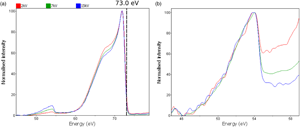Article contents
The Impact of Chemical Bonding on Mass Absorption Coefficients of Soft X-rays
Published online by Cambridge University Press: 14 May 2020
Abstract

Accurate elemental quantification of materials by X-ray detection techniques in electron microscopes or microprobes can only be carried out if the appropriate mass absorption coefficients (MACs) are known. With continuous advancements in experimental techniques, databases of MACs must be expanded in order to account for new detection limits. Soft X-ray emission spectroscopy (SXES) is a characterization technique that can detect emitted X-rays whose energies are in the range of 10 eV to 2 keV by using a varied-line-spaced grating. Transitions producing soft X-rays can be detected and accurate MACs are required for use in quantification. This work uses Monte Carlo modeling coupled with multivoltage SXES measurements in an electron probe micro-analyzer (EPMA) to compute MACs for the L2,3-M and Li Kα transitions in a variety of aluminum alloys. Electron depth distribution curves obtained by the software MC X-ray are used in a parametrized fitting equation. The MACs are calculated using a least-squares regression analysis. It is shown that X-ray distribution cross-sections at such low energies need to take into account additional contributions, such as Coster–Kronig transitions, Auger yields, and wave function effects in order to be accurate.
- Type
- Australian Microbeam Analysis Society Special Section AMAS XV 2019
- Information
- Copyright
- Copyright © Microscopy Society of America 2020
References
- 3
- Cited by



